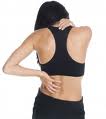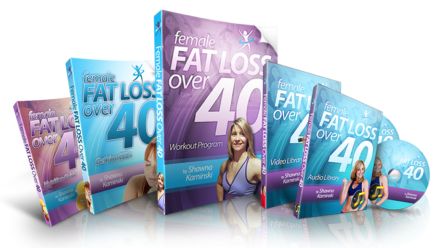5
Jun 10
Can you spot the person that just started working out? She’s the one hobbling around with sore quads and can’t sit down or get up every easily. Too funny, but not if it’s you! One of my clients using Female Fat Loss Over Forty contacted me to say that she was so sore she could barely move. She was disappointed to hear me cheer her on and remind her to get her workout in that day. She thought that I would offer some sympathy and tell her to go sit on the couch for a day. Ha! (Keep at it Cecilia, I’m so proud of you!)
If you want your body to look different, you have to move it in different ways, and that sometimes means muscle soreness. While it is important to get your behind off the couch, it’s equally important to become aware of your limitations. Unfortunately, many don’t find out about these until it’s too late. When it comes to exercise, a little goes a long way in the beginning. Moderation and realistic expectations are probably the most important things to keep in mind. Starting off slowly is a good way to keep the ball rolling in terms of adding movement into a sedentary life.
 Anyone starting out with a new program will expect some soreness. Most people are disappointed to hear that this will never end. I’ve been training for a very long time and I still get sore because I try to bring a higher intensity to my workout each day. However, I don’t get that debilitating soreness that comes at the start of your program that some experience. I suggest that you start off at about 60-70% effort for the first 2-3 workouts if you haven’t worked out in months to avoid this crippling soreness. You will be sore no matter what, why make yourself so miserably sore that you are reluctant to train again? By the fourth workout, you can bump up your effort to 90-100%.
Anyone starting out with a new program will expect some soreness. Most people are disappointed to hear that this will never end. I’ve been training for a very long time and I still get sore because I try to bring a higher intensity to my workout each day. However, I don’t get that debilitating soreness that comes at the start of your program that some experience. I suggest that you start off at about 60-70% effort for the first 2-3 workouts if you haven’t worked out in months to avoid this crippling soreness. You will be sore no matter what, why make yourself so miserably sore that you are reluctant to train again? By the fourth workout, you can bump up your effort to 90-100%.
What causes muscle soreness and is it a good thing?
Most will experience what’s called ‘delayed onset muscle soreness’ (DOMS) after starting something new. This is caused by the eccentric contraction or forceful contraction of muscles while lengthening. Microscopic muscle tears occur and the amount of soreness depends on the intensity of the work done to the muscle. This is a common and necessary response to resistance training in particular as muscles become stronger and develops stamina. Soreness peaks within the first two days of exercise and subsides after a few days. This is not an indication that you should quit exercising. In fact, getting back exercising will ease the pain of the soreness. DOMS should not be confused with a muscle strain or tear. This occurs while you are exercising and can be described as acute, unilateral pain, swelling and bruising.
I can’t move!
There are ways to alleviate DMOS. Following is a list of ways to make those muscles ache a little less even when you are pushing yourself to the limit:
- Warm up the muscles thoroughly.
- Cool down the muscles after exercise.

- Do stretching between sets.
- Increase intensity of exercise slowly over time.
- Get back into the gym. Even if you are sore, doing some light cardiovascular work on a bike or treadmill will usually loosen up muscles as blood is delivered to the aching areas.
- Avoid intense training of the sore muscles before hitting them hard with another workout.
- Non steroidal anti-inflammatory medications (such as ibuprofen) will reduce soreness temporily but will not speed healing.
The pain is gone… Now what?
That muscle soreness will subside with time. And when it does, it’s an indication that you need to push yourself a little more. I must say that soreness is not ALWAYS an indication that you’ve had a good workout, but it is somewhat telling. If you NEVER feel muscle tiredness, fatigue and SOME muscle soreness, it’s time to bump up the intensity. You’ve hit a plateau, and unless you want to stay at your current fitness level and look exactly the same, then it’s time to work more intensely. Don’t be fooled into thinking that this means a LONGER workout. Absolutely not. It means that you increase intensity by a variety of ways: increase resistance moved, increase volume of work, decrease rest time or any combination of these. A great way to increase intensity is to use my audio program or the workouts with in it.
Always a challenge…
 Your job in your fitness journey is to push yourself to new limits every day. As we age, this may mean meeting a similar challenge from our past. To me this is a step forward. (I’m proud to say that some of my athletic or training accomplishments today are the same as they were from years past. At the same time as my counter parts wouldn’t even dream of attempting some of the workouts that I do. So, while I may not be ‘improving’ as I age, my fitness and functionality are not declining as is everyone else’s.) Does that make sense to you? Try to push your limits, where ever or what ever they are, but be realistic and allow for enough recovery time. If you are really too sore to workout, try some lower intensity movement to ease up that soreness and try again the following day.
Your job in your fitness journey is to push yourself to new limits every day. As we age, this may mean meeting a similar challenge from our past. To me this is a step forward. (I’m proud to say that some of my athletic or training accomplishments today are the same as they were from years past. At the same time as my counter parts wouldn’t even dream of attempting some of the workouts that I do. So, while I may not be ‘improving’ as I age, my fitness and functionality are not declining as is everyone else’s.) Does that make sense to you? Try to push your limits, where ever or what ever they are, but be realistic and allow for enough recovery time. If you are really too sore to workout, try some lower intensity movement to ease up that soreness and try again the following day.
Honestly though, sometimes the best thing to do is to force those sore muscles to move with your regular high energy workout and you’ll be over the worst of that soreness before you know it. Just ask that trooper Cecilia, she’s reaping the benefits of pushing herself to her limits and she’s feeling better than ever. (I did hear my ears burning with some Spanish profanities there for a few days though!)




 My passion is teaching people how to work fitness into their daily lifestyle in order to improve their quality of life. Let’s work together to help you reach your fitness goals!
My passion is teaching people how to work fitness into their daily lifestyle in order to improve their quality of life. Let’s work together to help you reach your fitness goals!
I am a very fit person but I gained 10 lbs due to hormone changes my clothes are now tight I would like to loose 5 lbs so my beautiful clothes will look good on me again!
Are you on top of those hormonal changes? That’s a common experience with many of my clients. Have you seen your doctor to rule out other health issues? If so, and you have a clean bill of health, my program is designed specifically for you and these issues your facing. Check it out and stay tuned to my blog for ways to get back into your fav clothes and feeling fit and fabulous again.